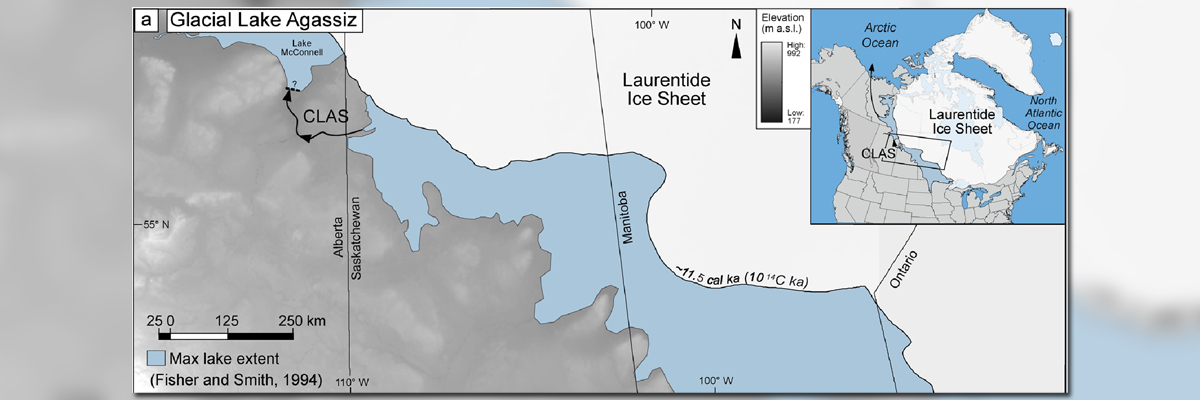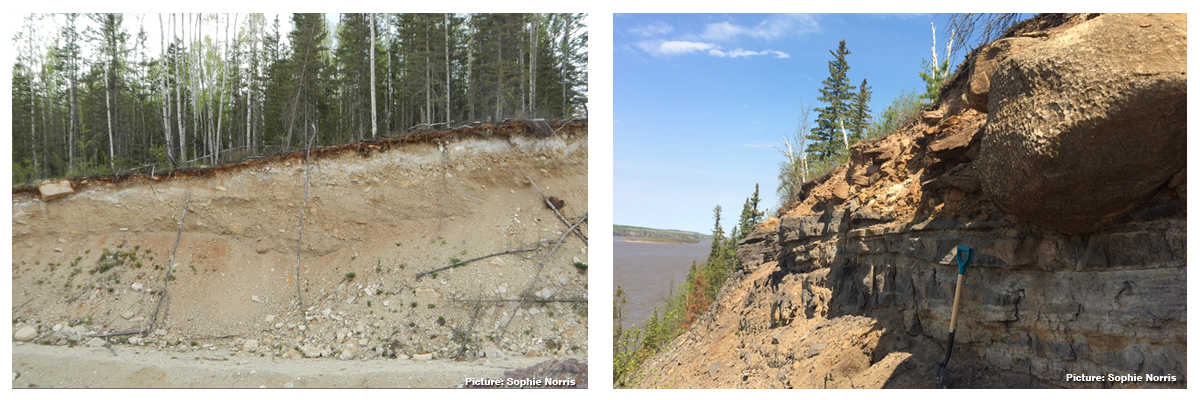A flood of epic proportions drained at a rate of more than 800 Olympic swimming pools per second from a glacial lake that spanned the Canadian Prairie provinces more than 12,000 years ago, according to a new University of Alberta-led study. In this work, led by Sophie Norris, a former University of Alberta Ph.D. student, has participated Daniel García Castellanos, researcher at Geociencias Barcelona (GEO3BCN-CSIC). The study has been published recently in the Geophysical Research Letters journal.
Geologists have long known of an ancient lake, Glacial Lake Agassiz, that occupied as many as 1.5 million square kilometers of what is now southern Manitoba and central Saskatchewan, up to the Alberta border. The lake formed as the three-kilometer-thick Laurentide Ice Shield atop the northern half of North America began to melt about 16,000 years ago, creating a dam that prevented would-be meltwaters from making their way to Hudson Bay.
Geomorphological evidence from northern Alberta also suggests that at some point that lake suddenly spilled out to the northwest along a major channel referred to as the Clearwater-Athabasca Spillway, through what is now Fort McMurray, into the Mackenzie River basin en route to the Arctic Ocean.

This study look now at how much water was discharged through the meltwater channel. “We know that a large discharge has gone through the area but the rate of the discharge or the magnitude was pretty much unknown,” said Norris, who is now a postdoctoral research fellow at Dalhousie University (Halifax, Canadá).
The team came up with an estimated discharge rate of two million cubic meters of water every second, at its height. That volume is about 10 times the Amazon River’s average discharge every second and one of the largest floods known on Earth. All told, the flood drained about 21,000 cubic kilometers of water—about the equivalent to what’s in the Great Lakes—in less than nine months.
Garcia-Castellanos from GEO3BCN-CSIC says that the study suggest that this event would be the largest terrestrial flood ever recorded as a result of the overtopping of a lake. “It also suggests that we are getting close to quantitatively understanding these rapid erosional-flooding events and linking them with the long-term erosion of landscapes”, says garcía-Castellanos.
Younger Dryas, a glacial period
The period in which this great flood occurred corresponds to an event known as the Younger Dryas, when just as the northern hemisphere was emerging from the ice age, it suddenly returned to near-glacial conditions.
“During the Late Pleistocene, temperatures were returning to normal, when the Earth slipped back into an ice age,” said Duane Froese, Norris’s PhD supervisor and Canada Research Chair in Northern Environmental Change in the Department of Earth and Atmospheric Sciences.
This megaflood would explain one of the biggest mysteries of the Earth’s recent climatic evolution: “12.900 year ago, the planet has abruptly cooled. In Greenland, for example, it is calculated that temperatures dropped about 10ºC and it lasted more than a millennium,” says García-Castellanos. This period is known as Younger Dryas, which preceded the current period, the Holocene”.
According to the GEO3BCN-CSIC researcher, “the causes of this phenomenon will be debated among the paleocimatologists and the geomorphologists, but this results point out that the massive flow of water could have triggered the climate change occured in the Younger Dryas by modifying the marine currents”. “However, the flood deposits are still not accurately aged enough to say that the flood happened exactly at the beginning of this cold period”, says García Castellanos.
“We don’t know for sure that the flood caused the Earth to slip back into the ice age, but certainly if you put that much water into the Arctic Ocean, the models show you get cooling of the northern hemisphere climate”, points out Norris, leading author of this study.
Geological cross-sections and a mathematical method
The first part of the study used sedimentary evidence to estimate the force of the water, as well as more than 100 valley cross-sections to estimate the size of the flows. The team also created a model of gradual dam failure using the erodibility of bedrock in the region and the size of the lake needed for a spillway through the upper portion of the Clearwater River. García-Castellanos task was focused on investigating the relationship between the water discharge occured during the flooding and the rock resistance in the area where the lake overtopped.

Besides, a mathematical method was used to simulate the gradual erosion process of the levee, which took into account the erodibility of the rocks and the size of the lake, required for the waters to end up pouring into the upper part of the Clearwater River. “The result is very motivating because it confirms the validity of this method. It can be applied to other similar floods that modified the terrestrial landscape after the last glacial period”, says García-Castellanos.
“What I find deeply satisfying is that modern hydraulic modeling, when applied to the evidence preserved in the landscape, shows how a phenomenal flood propagated 12,000 years ago,” said Paul Carling, study co-author from the University of Southampton, UK. “When all the uncertainties are considered, the outcome remains pretty solid.” he highlights.
Sophie Norris says that Alberta might owe part of its resource wealth to that great flood. “The oilsands region is essentially within the channel that this flood formed,” she says. “There would have been a huge amount of Quaternary material on top of that, as there is in the surrounding area, but it has been exposed in Fort McMurray by this huge event”, explains the researcher.
Adapted from Michael Brown, University of Alberta.
Reference paper
Norris, S. L., Garcia-Castellanos, D., Jansen, J. D., Carling, P. A., Margold, M., Woywitka, R. J., & Froese, D. G. (2021). Catastrophic drainage from the northwestern outlet of glacial Lake Agassiz during the Younger Dryas. Geophysical Research Letters, 48, e2021GL093919. https://doi.org/10.1029/2021GL093919
